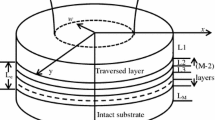Abstract
This paper presents SIMS data and analysis for dopant profiles of arsenic and boron implanted in silicon at energies up to 15 MeV. Arsenic and boron are widely used for very high energy implants into and adjacent to the photodiode region of CMOS image sensors to improve quantum efficiency and isolation. To avoid lateral shifts, shadowing effects, reduce implant damage, and to use channeling to increase ion penetration depth, the majority of high energy implants are performed at normal incidence or low beam tilt angles. Precise alignment and control of ion beam angles are, therefore, extremely important.
Graphical abstract





Similar content being viewed by others
Data availability
The datasets generated during and/or analyzed during the current study are available from the corresponding author on reasonable request.
References
S.I. Kondratenko, et al., Analysis of very high energy implantation profiles at channeling and non-channeling conditions. In Proceedings of the XXII International Conference on Ion Implantation Technology, 2018, p. 307
S. Satoh, J. David, Beam energy purity on Axcelis XE high energy ion implanter. In Proceedings of the XXI International Conference on Ion Implantation Technology, 2016, pp. 264–267
J. David, S. Satoh, Angle performance on Optima XE. In Proceedings of the 18th International Conference on Ion Implantation Technology, 2010, p. 373
R. Simonton, D. Kamenitsa, A. Ray, C. Park, K. Klein, A. Tasch, Channeling control for large tilt angle implantation in Si <100>. Nucl. Instrum. Methods Phys. Res. B 55, 39 (1991)
R. Simonton, L. Rubin, Channeling effects in ion implantation into silicon, in Ion Implantation, Science and Technology. ed. by J.F. Ziegler (Ion Implantation Technology Co., Yongin, 2000)
Acknowledgments
The authors would like to thank Eurofins EAG Laboratories for the SIMS analysis of high-energy-implanted dopant profiles.
Author information
Authors and Affiliations
Corresponding author
Ethics declarations
Conflict of interest
No funds, grants, or other support was received.
Additional information
Publisher's Note
Springer Nature remains neutral with regard to jurisdictional claims in published maps and institutional affiliations.
Rights and permissions
Springer Nature or its licensor (e.g. a society or other partner) holds exclusive rights to this article under a publishing agreement with the author(s) or other rightsholder(s); author self-archiving of the accepted manuscript version of this article is solely governed by the terms of such publishing agreement and applicable law.
About this article
Cite this article
Kondratenko, S., Rubin, L. Analysis of dopant distribution profiles of very high energy implants. MRS Advances 7, 1472–1475 (2022). https://doi.org/10.1557/s43580-022-00397-x
Received:
Accepted:
Published:
Issue Date:
DOI: https://doi.org/10.1557/s43580-022-00397-x




